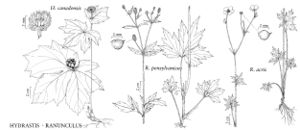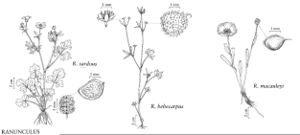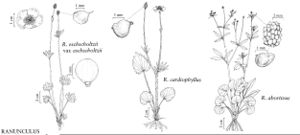Difference between revisions of "Ranunculaceae"
FNA>Volume Importer |
FNA>Volume Importer |
||
| Line 13: | Line 13: | ||
}}<!-- | }}<!-- | ||
| − | --><span class="statement" id="st- | + | --><span class="statement" id="st-undefined" data-properties=""><b>Herbs,</b> sometimes woody or herbaceous climbers or low shrubs, perennial or annual, often rhizomatous. <b>Stems</b> unarmed. <b>Leaves</b> usually basal and cauline, alternate or sometimes opposite, rarely whorled, simple or variously compound; stipules present or absent; petioles usually present, often proximally sheathing. <b>Leaf</b> blade undivided or more commonly divided or compound, base cordate, sometimes truncate or cuneate, margins entire, toothed, or incised; venation pinnate or palmate. <b>Inflorescences</b> terminal or axillary, racemes, cymes, umbels, panicles, or spikes, or flowers solitary, flowers pedicellate or sessile. <b>Flowers</b> bisexual, sometimes unisexual, inconspicuous or showy, radially or bilaterally symmetric; sepaloid bracteoles absent; perianth hypogynous; sepals usually imbricate, 3-6(-20), distinct, often petaloid and colored, occasionally spurred; petals 0-26, distinct (connate in Consolida), plane, cup-shaped, funnel-shaped, or spurred, conspicuous or greatly reduced; nectary usually present, rarely absent; stamens 5-many, distinct; anthers dehiscing longitudinally; staminodes absent (except in Aquilegia and Clematis); pistils 1-many; styles present or absent, often persistent in fruit as beak. <b>Fruits</b> achenes, follicles, or rarely utricles, capsules, or berries, often aggregated into globose to cylindric heads. <b>Seeds</b> 1-many per ovary, never stalked, not arillate; endosperm abundant; embryo usually small.</span><!-- |
-->{{Treatment/Body | -->{{Treatment/Body | ||
| − | |distribution=Worldwide | + | |distribution=Worldwide. |
|discussion=<p>Genera ca. 60, species 1700 (22 genera, 284 species in the flora).</p><!-- | |discussion=<p>Genera ca. 60, species 1700 (22 genera, 284 species in the flora).</p><!-- | ||
--><p>The flowers of many species of Ranunculaceae begin to open long before anthesis, while the floral organs are just partly expanded. Only mature flowers with open anthers should be used for determination of diagnostic characteristics (especially measurements).</p><!-- | --><p>The flowers of many species of Ranunculaceae begin to open long before anthesis, while the floral organs are just partly expanded. Only mature flowers with open anthers should be used for determination of diagnostic characteristics (especially measurements).</p><!-- | ||
| Line 233: | Line 233: | ||
|family=Ranunculaceae | |family=Ranunculaceae | ||
|illustrator=John Myers | |illustrator=John Myers | ||
| − | |distribution=Worldwide | + | |distribution=Worldwide. |
|reference=brayshaw1989a;duncan1991a;tamura1963a;tamura1993a;ziman1989a | |reference=brayshaw1989a;duncan1991a;tamura1963a;tamura1993a;ziman1989a | ||
|publication title= | |publication title= | ||
|publication year= | |publication year= | ||
|special status= | |special status= | ||
| − | |source xml=https://jpend@bitbucket.org/aafc-mbb/fna- | + | |source xml=https://jpend@bitbucket.org/aafc-mbb/fna-data-curation.git/src/9216fc802291cd3df363fd52122300479582ede7/coarse_grained_fna_xml/V3/V3_423.xml |
| − | |||
| − | |||
| − | |||
| − | |||
| − | |||
| − | |||
| − | |||
| − | |||
| − | |||
| − | |||
| − | |||
| − | |||
| − | |||
| − | |||
| − | |||
| − | |||
| − | |||
| − | |||
| − | |||
| − | |||
| − | |||
| − | |||
| − | |||
| − | |||
| − | |||
| − | |||
| − | |||
| − | |||
| − | |||
| − | |||
| − | |||
| − | |||
| − | |||
| − | |||
| − | |||
| − | |||
| − | |||
| − | |||
| − | |||
| − | |||
| − | |||
| − | |||
| − | |||
| − | |||
| − | |||
| − | |||
| − | |||
| − | |||
| − | |||
| − | |||
| − | |||
| − | |||
}}<!-- | }}<!-- | ||
-->[[Category:Treatment]] | -->[[Category:Treatment]] | ||
Revision as of 14:40, 27 July 2019
Herbs, sometimes woody or herbaceous climbers or low shrubs, perennial or annual, often rhizomatous. Stems unarmed. Leaves usually basal and cauline, alternate or sometimes opposite, rarely whorled, simple or variously compound; stipules present or absent; petioles usually present, often proximally sheathing. Leaf blade undivided or more commonly divided or compound, base cordate, sometimes truncate or cuneate, margins entire, toothed, or incised; venation pinnate or palmate. Inflorescences terminal or axillary, racemes, cymes, umbels, panicles, or spikes, or flowers solitary, flowers pedicellate or sessile. Flowers bisexual, sometimes unisexual, inconspicuous or showy, radially or bilaterally symmetric; sepaloid bracteoles absent; perianth hypogynous; sepals usually imbricate, 3-6(-20), distinct, often petaloid and colored, occasionally spurred; petals 0-26, distinct (connate in Consolida), plane, cup-shaped, funnel-shaped, or spurred, conspicuous or greatly reduced; nectary usually present, rarely absent; stamens 5-many, distinct; anthers dehiscing longitudinally; staminodes absent (except in Aquilegia and Clematis); pistils 1-many; styles present or absent, often persistent in fruit as beak. Fruits achenes, follicles, or rarely utricles, capsules, or berries, often aggregated into globose to cylindric heads. Seeds 1-many per ovary, never stalked, not arillate; endosperm abundant; embryo usually small.
Distribution
Worldwide.
Discussion
Genera ca. 60, species 1700 (22 genera, 284 species in the flora).
The flowers of many species of Ranunculaceae begin to open long before anthesis, while the floral organs are just partly expanded. Only mature flowers with open anthers should be used for determination of diagnostic characteristics (especially measurements).
The literature is inconsistent about the term for the whorl of organs between sepals and stamens; these may be conspicuous and petaloid, or reduced to stalked nectaries, or intermediate between the two states. They have been called petals, honey-leaves, or (when they are inconspicuous) staminodes or nectaries. We follow M. Tamura (1993) and treat as petals all organs between the sepals and stamens, except in Clematis and Aquilegia where they usually bear rudimentary anthers and clearly represent staminodes.
Selected References
Lower Taxa
Illustrations
Key
| 1 | Flowers bilaterally symmetric; sepals showy; petals smaller than sepals. | > 2 |
| 1 | Flowers radially symmetric; sepals showy or not; petals present or absent, smaller to larger than sepals. | > 4 |
| 2 | Upper (adaxial) sepal (hood) saccate or helmet-shaped; petals completely hidden by sepals. | Aconitum |
| 2 | Upper (adaxial) sepal spurred; petals at least partly exserted from calyx. | > 3 |
| 3 | Perennials; pistils 3(-5); petals 4, distinct. | Delphinium |
| 3 | Annuals; pistil 1; petals 2, connate. | Consolida |
| 4 | Fruits achenes or utricles; ovule 1 per pistil. | > 5 |
| 4 | Fruits follicles, capsules, or berries; ovules 2 or more per pistil (1 of 2 aborting in Xanthorhiza, leaving 1 seed at maturity). | > 12 |
| 5 | Sepals spurred; leaves all basal, blade linear or narrowly oblanceolate. | Myosurus |
| 5 | Sepals plane; leaves either not all basal, or blade not linear or narrowly oblanceolate. | > 6 |
| 6 | Leaves all cauline and opposite; stems ±woody, at least at base. | Clematis |
| 6 | Leaves cauline and alternate (rarely opposite), or basal, or plants with basal leaves and opposite or whorled involucral bracts; stems herbaceous. | > 7 |
| 7 | Plants with 1 or more pairs (opposite) or whorls of involucral bracts, these leaflike or calyxlike. | > 8 |
| 7 | Plants without involucral bracts (inconspicuous, linear-lanceolate involucral bracts in Trautvetteria), cauline leaves if present alternate (rarely a pair of opposite, unlobed leaves in Ranunculus sect. Flammula). | > 9 |
| 8 | Achenes with conspicuous veins or ribs on lateral surfaces; style absent. | Thalictrum thalictroides |
| 8 | Achenes without veins on lateral surfaces; style present. | Anemone |
| 9 | Petals absent; inflorescences panicles, racemes, or corymbs (umbels in Thalictrum thalictroides); filaments filiform or dilated distally. | > 10 |
| 9 | Petals present (rarely absent in Ranunculus pedatifidus); inflorescences simple or compound cymes or flowers solitary; filaments filiform. | > 11 |
| 10 | Leaves simple, blade lobed; flowers bisexual; inflorescences corymbs. | Trautvetteria |
| 10 | Leaves compound; flowers unisexual or bisexual; inflorescences panicles, racemes, corymbs, or umbels. | Thalictrum |
| 11 | Petals without nectaries; sepals 5(-8). | Adonis |
| 11 | Petals with basal nectaries; sepals 3-5(-6). | Ranunculus |
| 12 | Leaves dissected into linear, threadlike segments; pistils compound; fruits capsules. | Nigella |
| 12 | Leaves not dissected, if parted or compound the segments not linear; pistils simple; fruits aggregates of follicles or solitary or aggregate berries. | > 13 |
| 13 | Shrubs; beak of follicle lateral, strongly incurved against abaxial surface of follicle. | Xanthorhiza |
| 13 | Herbs; beak of follicle, if present, terminal or nearly so, straight or slightly curved, sometimes hooked at tip. | > 14 |
| 14 | Petals prominent, spurred. | Aquilegia |
| 14 | Petals if present inconspicuous, plane or funnel-shaped. | > 15 |
| 15 | Flowers 12-50, in racemes or racemelike panicles. | > 16 |
| 15 | Flowers 1-10, in leafy cymes or solitary. | > 17 |
| 16 | Pistils 1-8; fruits follicles, usually aggregate; petals 2-cleft or absent. | Cimicifuga |
| 16 | Pistil 1; fruits berries; petals unlobed. | Actaea |
| 17 | Leaves simple, blade often lobed 1/2-3/4 its length, margins entire, crenate, or toothed; petals absent. | > 18 |
| 17 | Leaves compound or divided to base; petals usually inconspicuous (absent in Enemion). | > 19 |
| 18 | Leaf blades unlobed, margins entire, dentate, or crenate; fruits follicles. | Caltha |
| 18 | Leaf blades lobed, margins serrate; fruits berries. | Hydrastis |
| 19 | Leaves ternately 1-2× compound. | > 20 |
| 19 | Leaves palmately or pedately compound or divided. | > 21 |
| 20 | Leaves all basal; leaf blade deeply divided, ternately or pinnately 1-2× compound; petals present. | Coptis |
| 20 | Leaves basal and cauline; leaf blade ternately 2× compound; petals absent. | Enemion |
| 21 | Leaf segments lobed, margins sharply toothed; sepals persistent in fruit. | Helleborus |
| 21 | Leaf segments cleft or parted, margins entire or toothed; sepals not persistent in fruit. | > 22 |
| 22 | Cauline leaves absent except for whorl of 3 involucral bracts immediately subtending flower; follicles stipitate. | Eranthis |
| 22 | Cauline leaves alternate, (0.8-)1 cm or more from flower, involucral whorl absent; follicles sessile. | Trollius |


